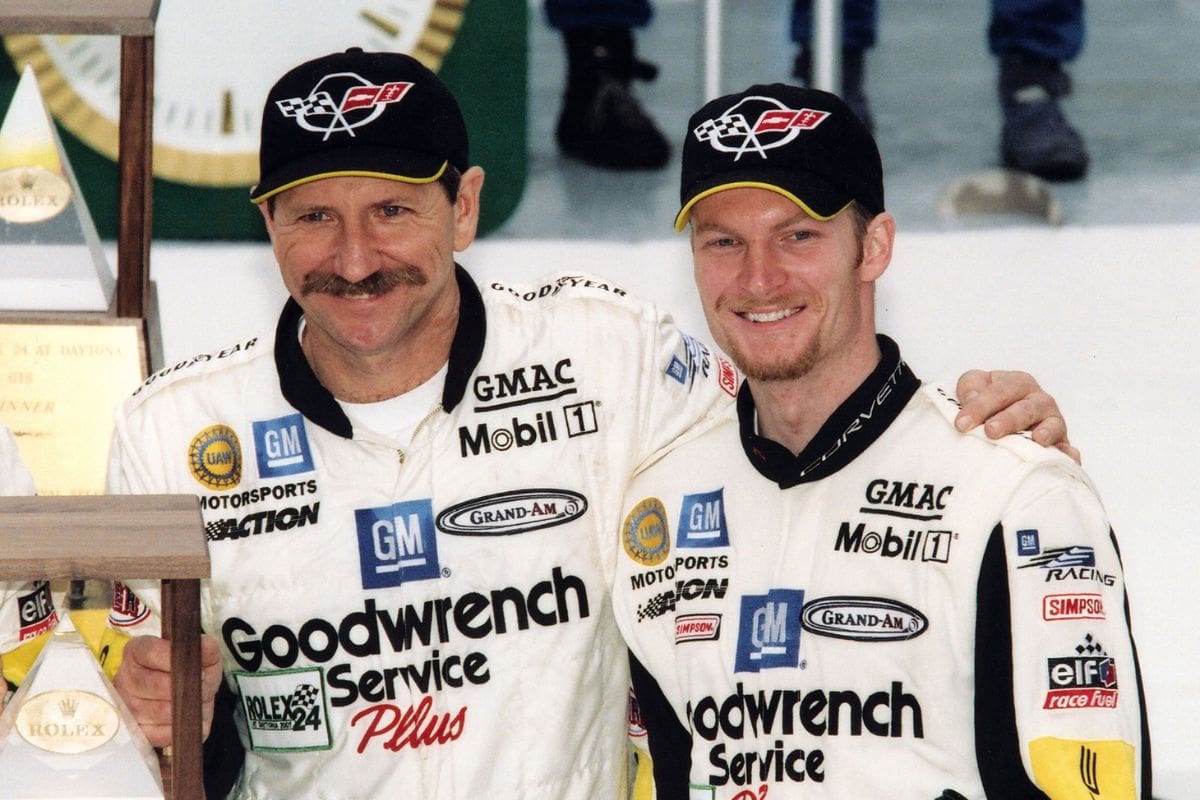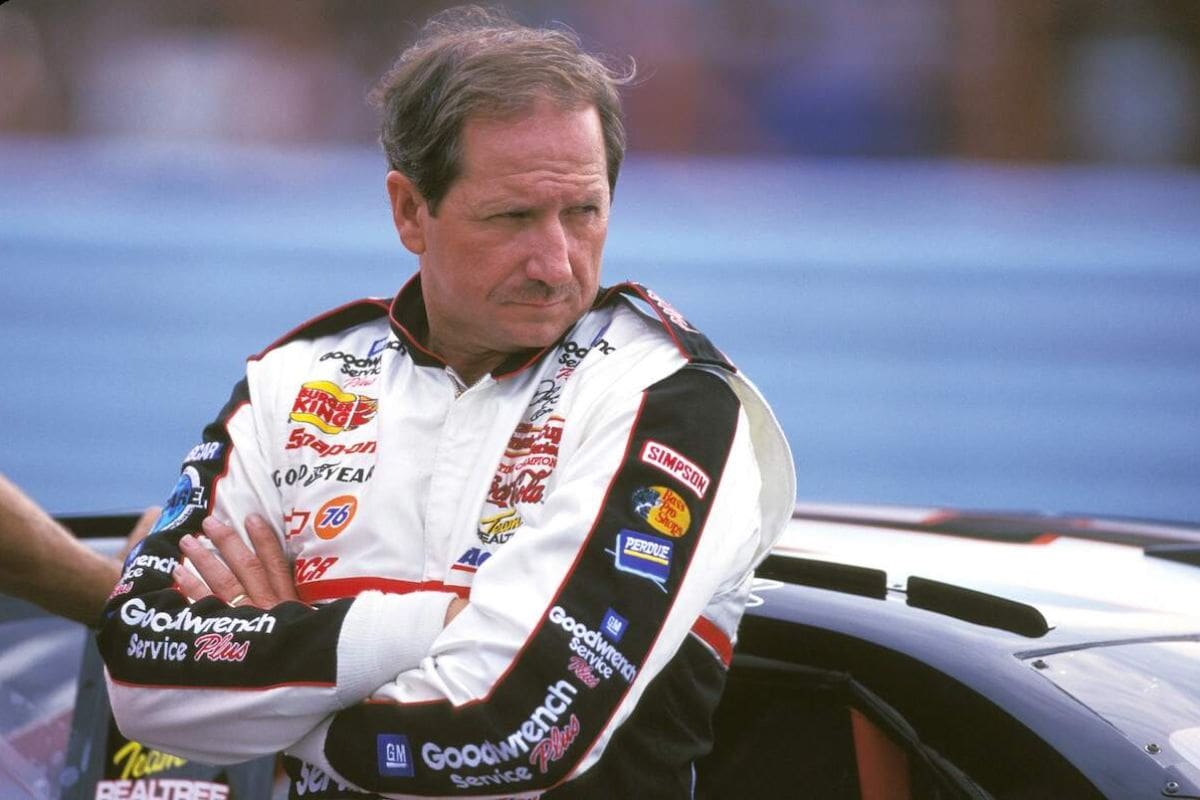Dale Earnhardt Sr. and Rusty Wallace Feud: Dale Earnhardt Jr. has highlighted the feud between his father, Dale Earnhardt Sr., and Rusty Wallace. This rivalry intensified during the infamous 1995 Bristol Cup race, where a contentious bump led to Wallace spinning out, fracturing their earlier alliance against Jeff Gordon. Earnhardt Sr.’s aggressive tactics sparked public debate and devastated the trust between the two drivers. Wallace’s emotional response was marked by disbelief and frustration, emphasizing the intensity of their competition. This feud not only shaped their careers but left a lasting impact on NASCAR, revealing complex dynamics that continue to resonate today.
Key Highlights
- Dale Jr. highlights the intense rivalry between Earnhardt Sr. and Rusty Wallace, rooted in competitive dynamics and personal conflicts.
- The 1995 Bristol incident marked a pivotal moment in their feud, showcasing Earnhardt Sr.’s aggressive driving style.
- An initial alliance between Earnhardt Sr. and Wallace to confront Jeff Gordon dissolved due to a breach of trust during the race.
- Wallace’s emotional response to Earnhardt Sr.’s tactics included disbelief and anger, symbolizing the personal stakes in their rivalry.
Background on Dale Earnhardt Sr. and Dale Earnhardt Jr.
Dale Earnhardt Sr. and Dale Earnhardt Jr. are iconic figures in the world of NASCAR, with the former establishing a legendary legacy as a seven-time Cup Series champion and the latter carving out his own path as a two-time Xfinity Series champion and a beloved personality in the sport. The relationship between father and son is representative of the sport’s intertwining of personal and professional narratives.
Dale Earnhardt Sr., known as ‘The Intimidator,’ dominated the NASCAR landscape with unmatched skill and tenacity over a career that spanned 26 years. His aggressive driving style not only won him championships but also earned him a reputation that transcended the sport. This fierce approach influenced countless drivers and shaped the competitive ethos of NASCAR.
In contrast, Dale Earnhardt Jr. entered the NASCAR arena in 1996, debuting in the Busch Series (now Xfinity). Following in his father’s footsteps, he quickly distinguished himself by winning back-to-back championships in 1998 and 1999. Despite achieving 26 race wins in the Cup Series, Dale Jr. faced the challenge of living up to his father’s monumental success. His quest, marked by resilience and dedication, has endeared him to fans, making him a respected figure both on and off the track.
The Intimidator and the 1995 Bristol Incident
The fierce competitiveness that defined Dale Earnhardt Sr.’s career was vividly illustrated during the intense 1995 Cup Race at Bristol Motor Speedway, a pivotal moment recounted by Dale Jr. in a recent podcast. This race not only highlighted Earnhardt’s driving skill but also emphasized the simmering tensions between him and fellow competitor Rusty Wallace. As the race unfolded, their fierce rivalry reached a boiling point that would leave an indelible mark on NASCAR history.
In the closing laps, Wallace, who had been vying for position, found himself in a contentious battle with Earnhardt. The situation escalated when Earnhardt, known for his aggressive racing style, asserted his dominance, leading to a collision that resulted in Wallace’s car spinning out. The incident ignited a fierce debate among fans and commentators, with many questioning the ethics of Earnhardt’s driving tactics.
This rivalry not only exemplified the significant stakes of NASCAR but also highlighted the intensity of Earnhardt’s character, earning him the moniker ‘The Intimidator.’ Dale Jr.’s recounting serves as a reminder of the complex dynamics that shaped the sport during this era.
The Agreement and Its Breach
At a crucial moment of NASCAR history, an agreement forged between Rusty Wallace and Dale Earnhardt Sr. to collaboratively confront the emerging threat of Jeff Gordon ultimately unraveled during the high-stakes race at Bristol, leading to an unexpected betrayal that would deepen their rivalry.
“Rusty and dad had been talking,[…] They were both recognizing that Jeff Gordon was going to be something they were going to have to deal with long term, and so they felt like that you know at Bristol between the two of them they would decide not to give each other a hard time and team up and and give everything they could to Jeff Gordon.” – dale jr
Recognizing Gordon’s talent and potential to disrupt their dominance, the two seasoned drivers had pledged to support each other during the race, vowing to refrain from engaging in their usual competitive tactics.
However, as the race unfolded, the fragile alliance quickly disintegrated. In a moment that shocked Wallace, Earnhardt Sr. executed a decisive bump, sending his ally careening into the wall. This act not only undermined their pre-race agreement but also signaled a shift in the dynamics of their relationship.
Wallace, taken aback by the sudden aggression, felt a profound sense of betrayal; the trust established during their private discussions evaporated in an instant.
The consequences of this breach extended far beyond that single race. Wallace’s feelings of deception transformed into resentment, foreshadowing a rivalry that would become one of the most talked-about narratives in NASCAR.
The incident at Bristol not only marked the beginning of a more contentious relationship between the two drivers but also set the stage for the ongoing battle against Jeff Gordon, whose rise to prominence would only intensify their competitive spirits.
Wallace’s Reaction and Aftermath
Rusty Wallace’s immediate reaction to Earnhardt Sr.’s betrayal was one of disbelief and anger, emotions that were vividly captured by those present in the pits as he confronted the reality of their fractured alliance. The tension escalated dramatically when, after finishing the 1995 Goodys 500-night race in Bristol, Wallace, feeling shortchanged and betrayed, hurled a water bottle at Earnhardt Sr. This act of frustration not only emphasized the intensity of Wallace’s feelings but also highlighted the gravity of their broken agreement.
“The race gets going, and Dad pops Rusty in the back end sends Rusty in the wall, and Rusty’s like what the hell? We were not going to do that,[…]It’s almost like Rusty felt like dad lied to him you know and then took advantage of it, and so it seemed like he showed his frustration after the race.” – Dale Jr.
The aftermath of this incident reverberated throughout the NASCAR community. Wallace’s public display of anger was more than just a momentary outburst; it signified a crucial shift in the dynamics of their relationship and the broader racing environment. As the dust settled from the confrontation, both drivers faced the consequences of their actions, with Wallace grappling with the implications of his volatile response while Earnhardt Sr. navigated the fallout of his breach.
In the days and weeks that followed, Wallace’s focus shifted from personal grievances to competitive resolve. The incident catalyzed a fierce resolve to reclaim his position in the sport, culminating in a renewed commitment to excellence on the track. This confrontation, while initially a source of discord, ultimately served as a turning point for Wallace, shaping the course of his career and setting the stage for future rivalries within NASCAR.
Dale Earnhardt Jr.’s Racing Career Post-Retirement
How has Dale Earnhardt Jr. navigated his racing career post-retirement, balancing a passion for the sport with the realities of life beyond full-time competition?
Since stepping away from the rigors of full-time NASCAR participation, Earnhardt Jr. has accepted a selective approach to racing that allows him to maintain a connection to the sport while prioritizing his personal life.
“I don’t enjoy [it] at my age and what I got going on with my life, to get in a car and have to run as hard as you can, run Q laps [qualifying], every lap of the race where there’s not really whole lot of fall off, it’s just not that interesting to me. [However] I love watching it. I love watching other people do it.” – dale jr
Key elements of his post-retirement racing strategy include:
- Limited Participation: Dale Jr. competes in at least one Xfinity race each season, allowing him to stay connected without the strain of a full schedule.
- Exploration of Other Series: His recent foray into the Late Model Stock Car series, where he finished 5th in the Hampton Heat 200, highlights his willingness to diversify his racing experiences.
- Prioritizing Enjoyment: In interviews, he has expressed a preference for watching races rather than enduring the intense demands of competitive driving, reflecting a desire for enjoyment over stress.
- Mentorship and Broadcasting: Beyond driving, Earnhardt Jr. has taken on roles in broadcasting and mentorship, sharing his extensive knowledge of the sport while fostering new talent.
𝑭𝒊𝒓𝒔𝒕 𝑻𝒊𝒎𝒆 𝑭𝒐𝒓 𝑫𝒂𝒍𝒆 𝑱𝒓 – @DaleJr is making his @LangleySpeedway debut in tonight's #HamptonHeat. He practice on Friday and caught up with our @RobBlount to discuss what his first laps on this challenging race track were like 👇 pic.twitter.com/ILHMy40GTo
— FloRacing (@FloRacing) July 20, 2024
This careful balance allows Dale Earnhardt Jr. to remain an influential figure in NASCAR, ensuring that his legacy endures while he enjoys the freedom that comes with retirement.
News in Brief: Dale Earnhardt Sr. and Rusty Wallace Feud
The disclosure of the feud between Dale Earnhardt Sr. and Rusty Wallace highlights the complexities of relationships within the competitive domain of NASCAR.
The 1995 Bristol incident exemplifies how on-track rivalries can escalate beyond the race, leading to broken agreements and lasting animosity.
This historical context enriches the narrative of both drivers, showing how personal dynamics intertwine with professional legacies.
Ultimately, such conflicts have shaped the sport’s evolution and continue to influence contemporary racing culture.
ALSO READ: Dale Earnhardt Jr. Stands Up for Kyle Busch Amidst Historic NASCAR Challenge




